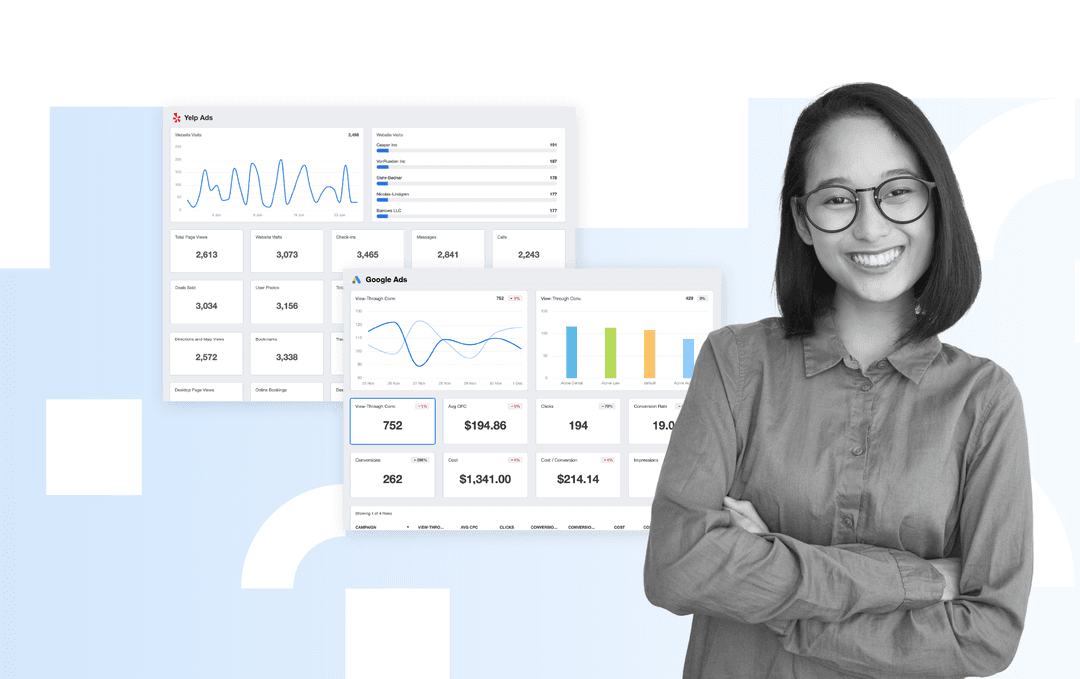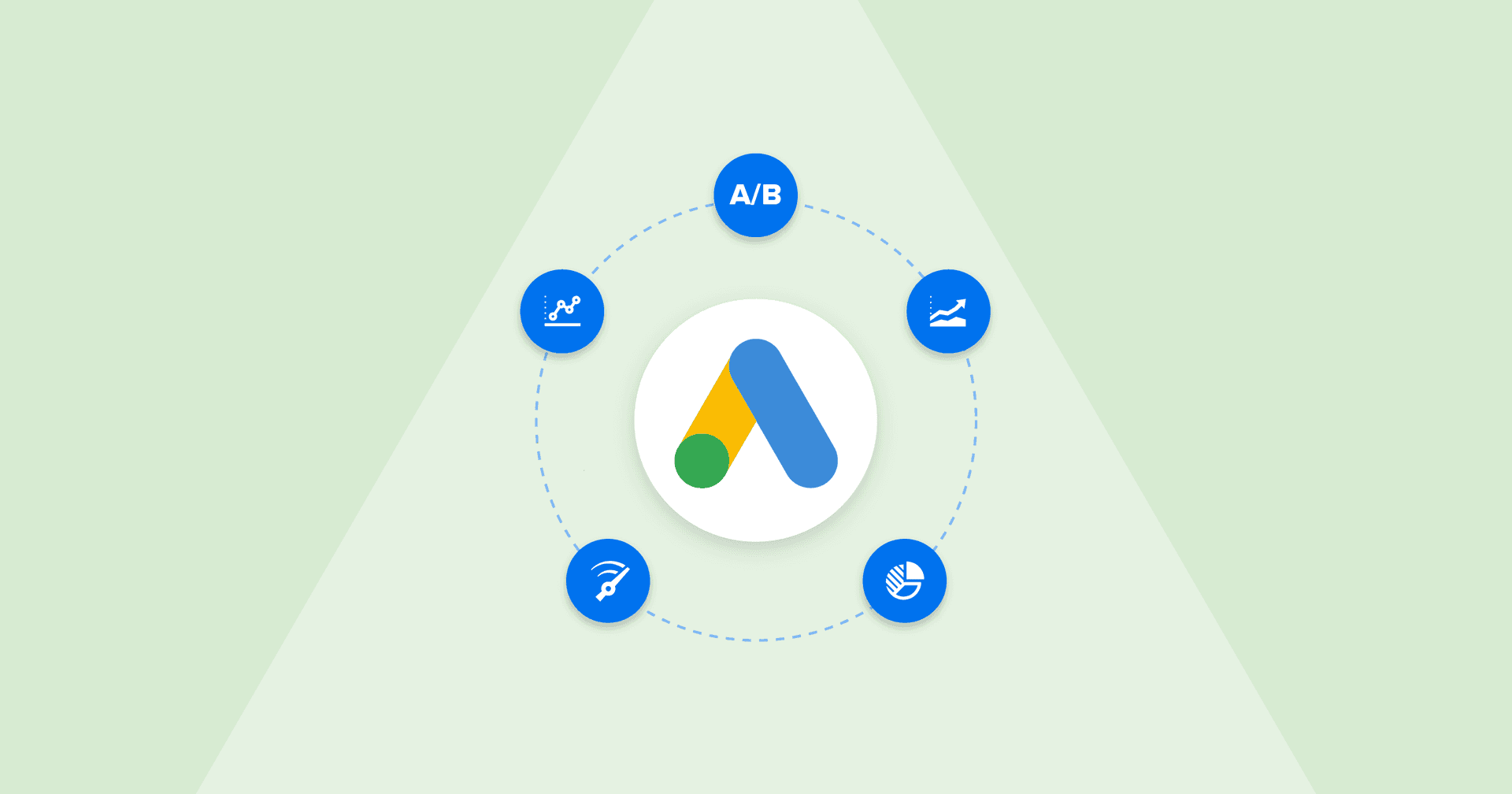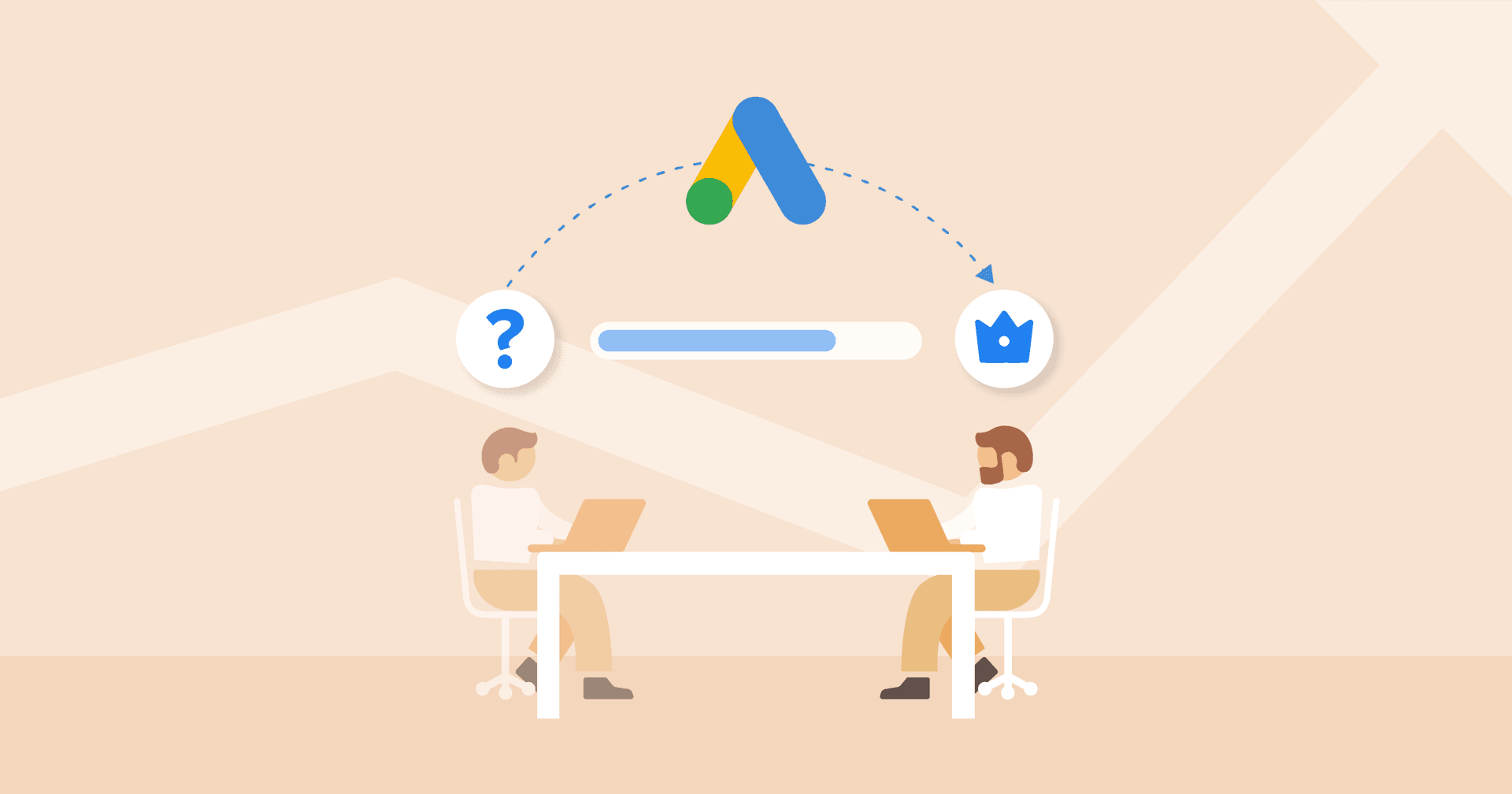Table of Contents
QUICK SUMMARY: Your clients count on you to make every ad dollar count. Some need the scale and targeting of Google Ads. Others thrive on Yelp’s review-driven approach. This guide compares formats, costs, and audience intent, so you’ll build PPC campaigns that attract customers and drive ROI.
Deciding where your client’s online advertising budget should go? It’s rarely a black-and-white call. Google brings the reach. Yelp brings the timing—people land there when they’re ready to book, not just browse.
Both ad platforms can work. The trick is figuring out which one fits your client’s goals, audience, and buying cycle.
So, who takes the win in the Google Ads vs. Yelp Ads match-up?
We’ll break down targeting options, ad formats, search intent, cost, and when it makes sense to run PPC campaigns on both. By the end, you’ll know when Google dominates, where Yelp shines, and how to play both to your advantage.
What is Google Ads?
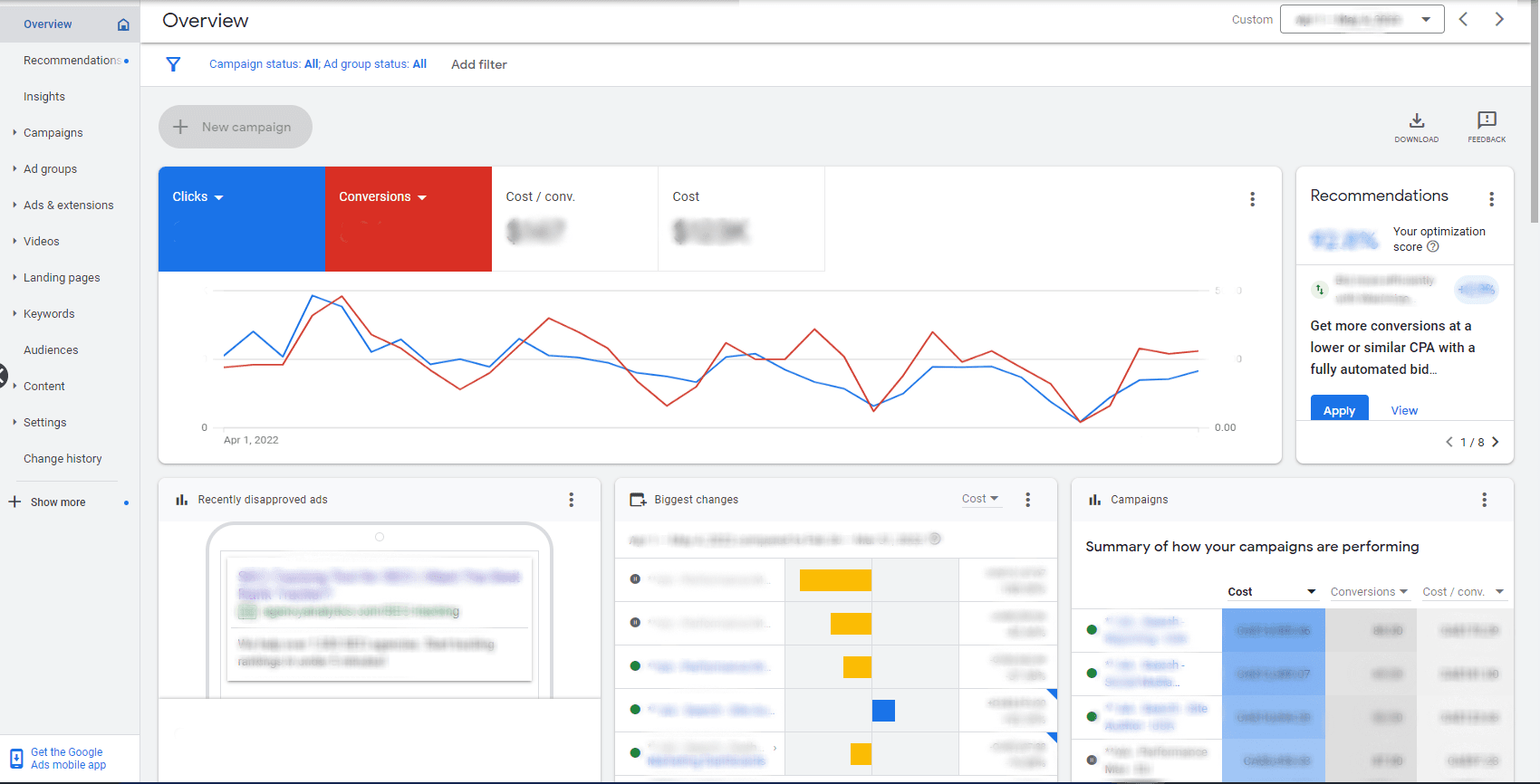
Let’s say your client is a major internet provider. They want to target prospective customers who are thinking about switching providers. These are consumers who aren’t ready to buy yet, but are just in research mode. Chances are, those customers will start with Google to see what’s out there.
Enter Google Ads.
Google Ads appear right at the top of the Google search results as sponsored listings, hitting early in the sales funnel—when potential customers are searching, comparing, and figuring out what they need.
Because the Google ecosystem includes YouTube, Maps, Gmail, and the Google Display Network, Google Ads keeps your client’s brand visible whether their audience is watching how-to videos, checking directions, or reading reviews.
Depending on your campaign type, you can run:
Shopping ads (great for ecommerce)
Display ads (image-based ads across websites)
Video ads (on YouTube)
App promotion ads
Local campaigns
Performance Max campaigns (which run across all of the above)
Beyond its obvious reach, the power of Google Ads is in its keyword targeting and budget control. You choose which search ads appear, adjust bids based on performance, and track results through Google Analytics. It’s one of the most flexible advertising platforms for driving online sales, landing page visits, phone calls, and conversions—whether you're targeting by ZIP code, device, or time of day.
What is Yelp Ads?
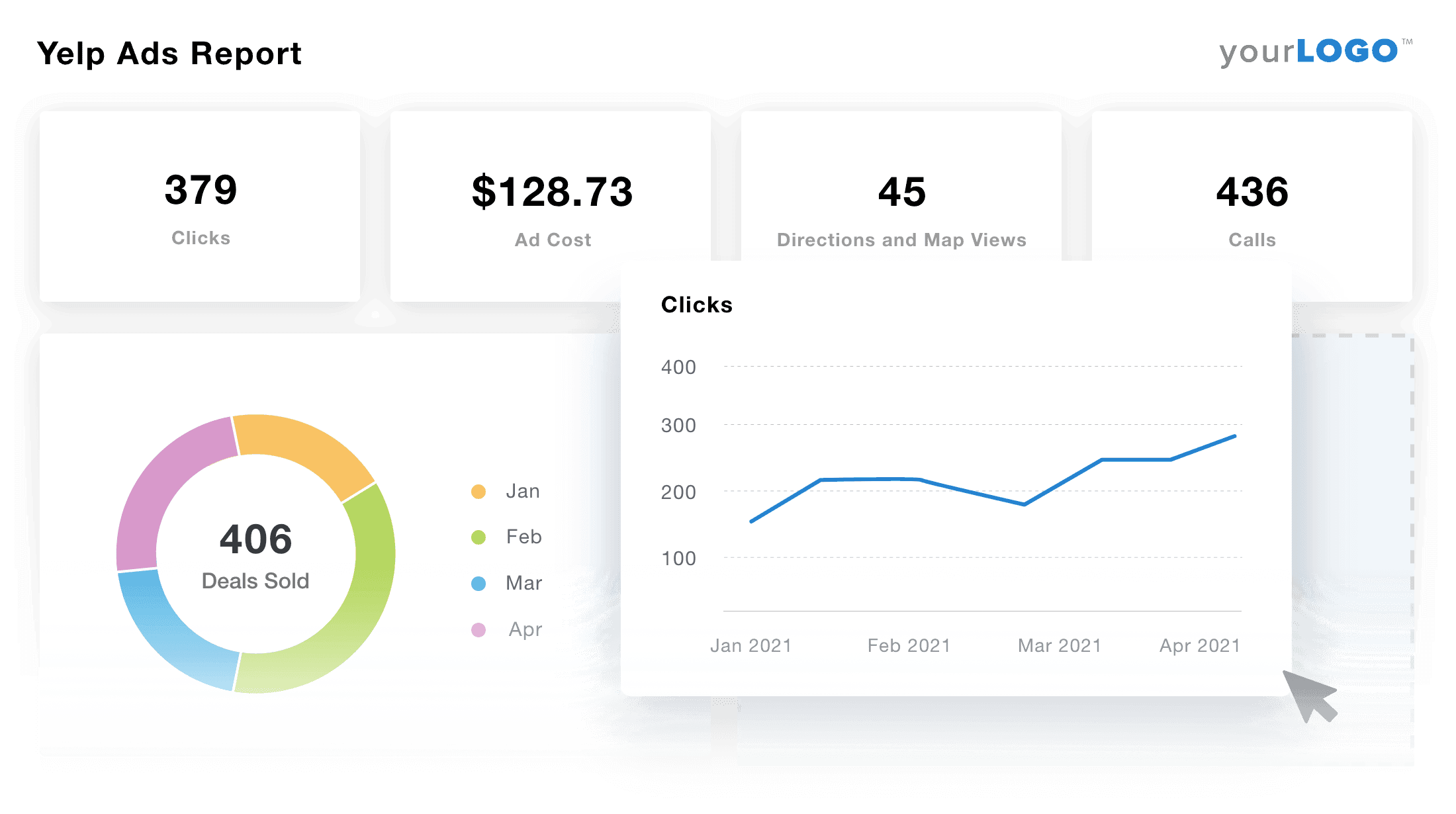
Yelp Ads puts your client’s business in front of people who are further along in the sales funnel. They’ve done their research, know what they want, and now they’re ready to choose a provider.
Like Google, Yelp Ads appear as sponsored listings at the top of relevant search results. But they also show up directly on competitors’ pages, giving you a chance to attract customers who are already reading another business’s reviews.
The biggest advantage? Simplicity. Yelp advertising handles targeting automatically based on category, location, and user behavior. And there’s only one ad format, so setup is quick and easy.
Here’s the tradeoff: it’s all pay-per-click. That means even if someone bounces, you still pay for the visit. Because of this, Yelp Ads work best for businesses with positive reviews, up-to-date information, and eye-catching visuals.
Key differences between Google Ads and Yelp Ads
Google Ads and Yelp Ads both get your clients in front of potential customers. But how, where, and who their ads reach? That’s where things differ.
Audience and reach
Let’s start with size. With over 105 billion monthly visits across search ads, the Google Display Network, YouTube, and Maps, Google Ads leads in reach. Yelp ads, by comparison, see around 178 million monthly visitors. Smaller, yes—but as any marketer knows, it’s not just about volume. It’s about timing and intent.
Because Google’s net is so wide, it catches people at every stage of the sales funnel, whether they’re doing early research, price shopping, or making a last-minute decision. Yelp Ads casts a smaller net, but most users are actively searching for local services. And depending on who you're targeting, Yelp’s audience can be a sweet spot:
56% of users earn $100K+ per year
73% have a post-secondary education
So, if your client’s target audience skews higher-income and college-educated, Yelp Ads gives you a direct line to them.
Cost and ROI
Both platforms use a pay-per-click model, but the way costs are set and how much value you get from it can vary.
Google Ads: More control, better ROI tracking
Uses an auction system based on keyword competition.
Average CPC is $4.51 (based on 10,000+ high-intent keywords). But in competitive industries like legal and insurance? You’re looking at $67-$71. Wild, but true.
You can set daily budgets, adjust bids in real time, and pause or scale campaigns whenever you need to.
Built-in conversion tracking ties ad spend to actual results—whether it’s purchases, form submissions, or phone calls—and makes it easy to tweak for better ROI.
Agency tip: Not sure how much you should be bidding? Our Google Ads Budget & Bidding Strategy guide walks you through the whole thing: bids, budget pacing, and what to tweak when performance dips.
Yelp Ads: Higher costs, less control
Ads are automatically matched by category and location, so you don’t have to worry about keyword bidding.
Average CPC is $3–$4 (and yes, it can also go higher in competitive industries).
You’re charged for every click, even if the user bounces without engaging.
Most small business packages start around $300 a month. Add extras like profile upgrades, call-to-action buttons, or premium placement, and that number can climb past $600.
Performance depends more on how polished your client’s Yelp listing is. Think: great reviews, solid photos, and clear info over fancy targeting.
Ad formats and features
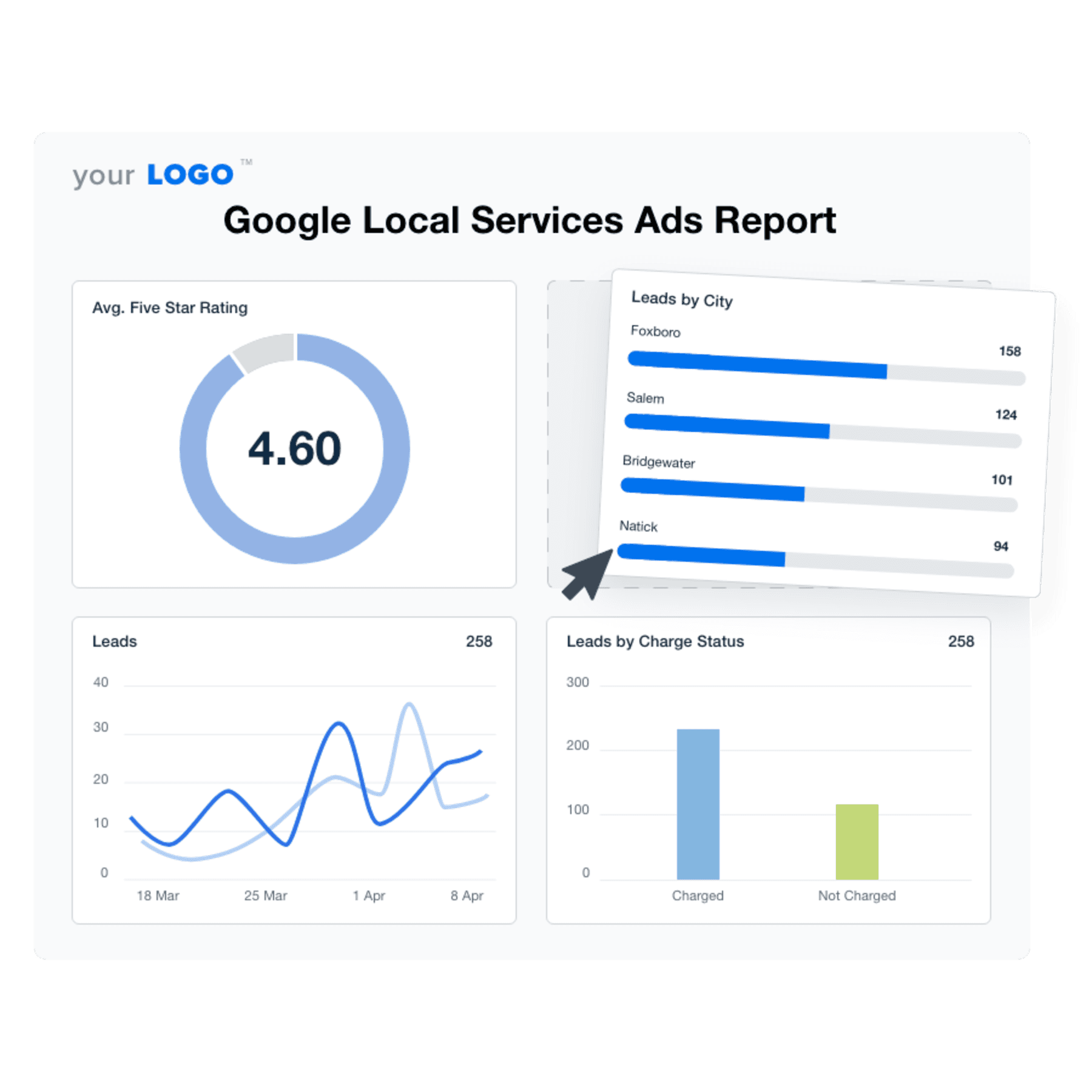
Google Ads: Full control, full menu
Google Ads offers the full buffet, with multiple ad formats and controls to match your client’s goals, budget, and target audience:
Search, shopping, display, video, and app ads: Ensure that your client shows up when someone Googles “brunch spots near me,” watches a haul video on YouTube, or scrolls through a blog about clean beauty. Or run them all together in one Performance Max campaign.
Granular features that do the heavy lifting: Target search terms like “organic dog treats.” Add negative keywords to skip low-intent clicks. Build remarketing lists from cart abandoners. Then track conversions by product, location, or channel. With tools like Smart Bidding and location extensions, Google lets you fine-tune every part of the ad experience.
Yelp Ads: Less to tweak, easier to launch
Yelp Ads is more of a fixed plate than a full buffet, but for the local businesses, it works.
You get one ad format, no keyword setup, and zero audience stress. Yelp handles targeting based on category, location, and user behavior.
Ads show up in sponsored listings and competitors’ pages, giving your client a shot at attracting customers actively searching for local services.
What matters most? Your client’s Yelp listing. Great reviews, clean photos, and clear info go further here than fancy targeting ever will.
Fewer knobs to twist, fewer things to break, making it ideal for local businesses that want to get in, get seen, and get back to work.
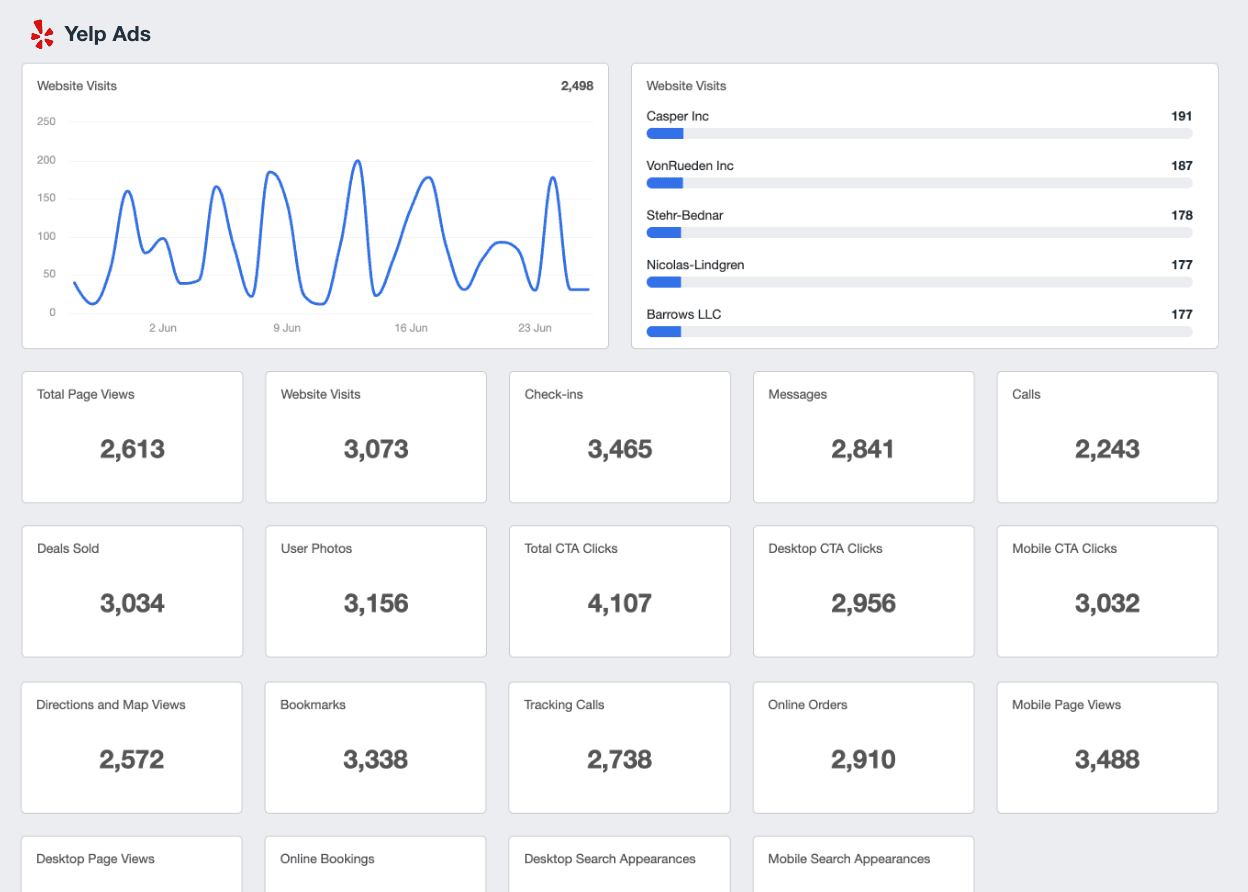
Trying to figure out which platform pulls its weight or if running both makes sense for your client? Start your free trial of AgencyAnalytics and get the full view, side by side.
Clients don't want to see 7 reports, one per platform: Facebook Ads, Google Ads, Email Marketing, Website Analytics, etc. They want everything condensed into one, easy-to-read report, where they can view all of their most significant marketing data in one place. The AgencyAnalytics customizable marketing reports allow us to do just that. The clients love them and we do too.
Graham Lumley, Director of Growth Marketing, Blackhawk
When to choose Google Ads
One client is scaling an online store. Another’s running weekend promos for a bakery down the block. Different goals, different needs. And while Google Ads has the biggest reach, it’s not always the right call for every client.
Let’s take a look at when it’s best to use Google Ads:
Your client needs reach beyond one location
Some clients stay local. Others want to grow across the country or even further. With Google Ads Performance Max, you can help them do it without rebuilding from scratch.
Say your client’s a mobile pet grooming service with a strong base in Calgary. Now they’re eyeing Edmonton and Kelowna. You can run search campaigns for “mobile dog grooming” in each city, tailor the copy, and follow up with display ads while pet owners browse local blogs or check the weather. Same platform, consistent reach, wherever they go.
You want full keyword targeting
To optimize ad spend, your client needs to show up for the right searches and skip the wrong ones. With Google Ads, you’re not just hoping the right people see the ad. You can target high-intent terms that match exactly what your client offers and filter out the rest.
Running ads for a private tutoring service? Bid on “math tutor Vancouver,” then add negative keywords like “free” or “group class” to skip mismatched clicks.
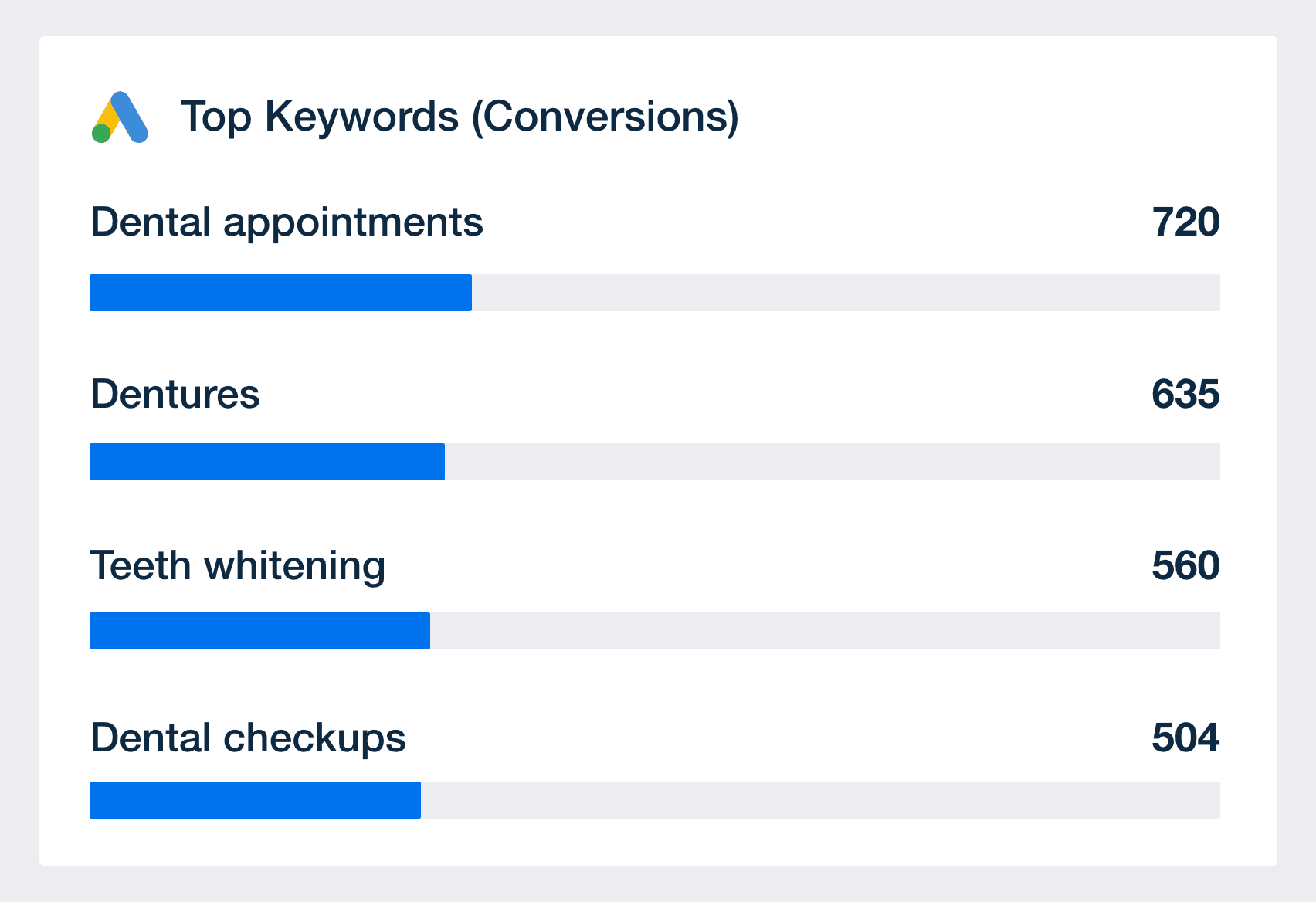
You need custom landing pages and conversion tracking
One of the biggest upsides of Google Ads? You control where the click lands. Instead of sending visitors to a generic homepage or cluttered profile, you guide them to a landing page built to convert.
Agency tip: Link Google Ads with Analytics and Tag Manager to track what’s converting, what’s not, and why. Our Google Ads A/B Testing Guide shows you how to test headlines, forms, and layouts, so your next change isn’t a guess—it’s a win.
Retargeting is part of the strategy
Not every click turns into a customer on day one. Maybe someone checks out your client’s landscaping services, then bounces. A few days later, they’re watching a yard makeover video or scrolling a local real estate blog and there it is: your client’s ad with 10% off spring cleanup. This time, they book.
That’s the magic of Google’s remarketing tools. They keep your client top of mind until the moment’s right to book.
Agency tip: Clients pushing for Meta instead? Use Google Ads vs. Facebook Ads comparison guide to settle the debate, fast.
When to choose Yelp Ads
Yelp Ads keeps things simple. But when it comes to attracting nearby customers, especially for small businesses and service industries, it can punch way above its weight.
Here’s when it’s usually the better fit:
They’ve got a strong reputation
Yelp Ads is all about review-based advertising. Every ad click leads users to a profile packed with star ratings, photos, and real customer experiences.
Say you’re running ads for a local dental clinic with a 5-star rating, 100+ positive reviews, and a steady stream of check-ins. Someone searches “dentist near me,” your client’s listing shows up first, and their customer reviews do the selling for you.
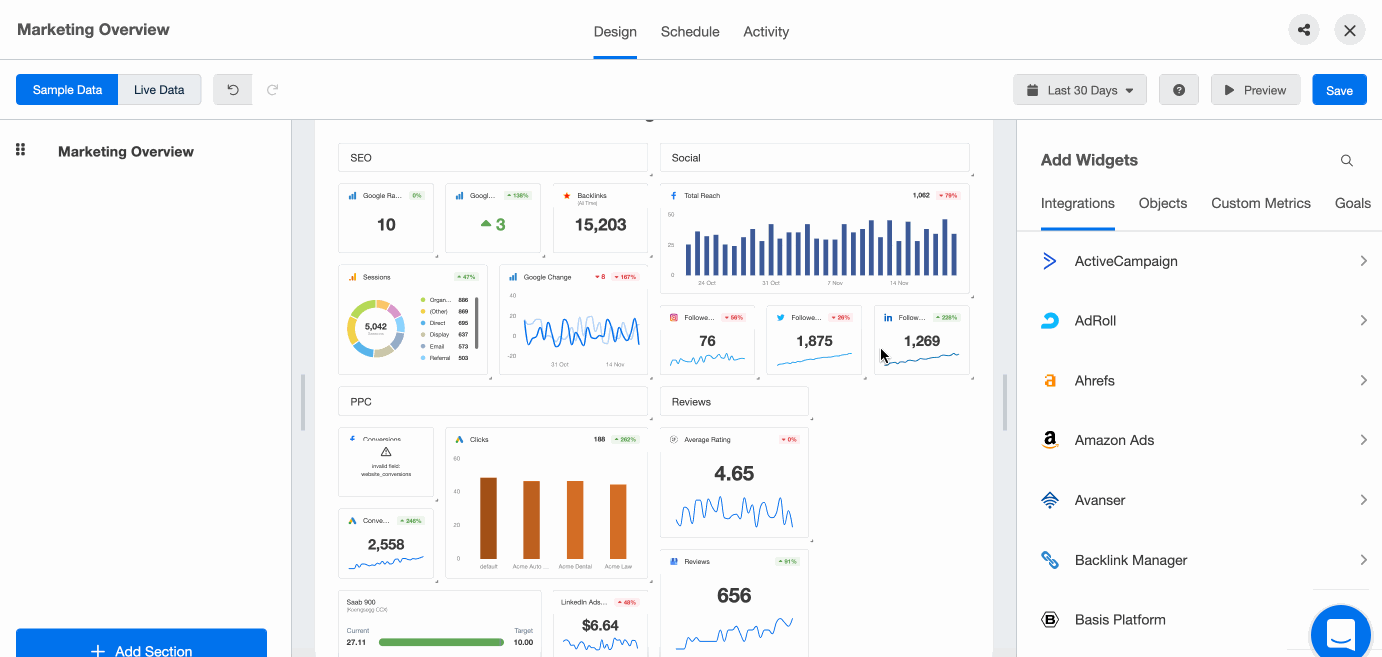
Add Yelp data to your Review Report with a simple drag and drop! Check it out for free with your 14-day AgencyAnalytics trial.
They’re in a Yelp-friendly industry
Yelp isn’t for everyone, but for service-based businesses where reviews drive decisions, it’s hard to beat. Think med spas, dog groomers, restaurants—places people search for nearby, skim star ratings, and book fast.
Yelp Ads automatically puts your client in front of people actively searching for local services, without the setup stress of building full campaigns in Google Ads.
Their customers are comparison shopping
Unlike Google, Yelp isn’t where people start the search. It’s where they narrow it down. When someone lands on a results page, they’re staring at your client’s name right beside a direct competitor. Same star rating. Same neighbourhood. Same service. Yelp Ads gives your client a shot to win the click, where one great photo or review makes all the difference.
Their business depends on trust and local traffic
Some businesses rely on foot traffic and snap decisions. People search, skim, and choose whoever looks best—usually in under a minute. That’s where Yelp Ads can make the difference. Say your client owns a trendy brunch café in LA. A couple visiting from out of town searches “best brunch near me” on Yelp. They don’t know the neighbourhood, so they’re picking based on reviews, photos, and who shows up first. If your client’s ad appears up top with a 4.8 rating and a feed full of patio pics and avocado toast? That’s it. They’re going.
Combining Google Ads and Yelp Ads: Is it worth it?
Short answer: Maybe. It depends on your client’s business type, goals, and how they want to spend their advertising dollars. But when it works, it really works.
Instead of trying to increase the budget on a single campaign or platform, we work on creating a wide range of ads with predetermined budgets of different styles and on different platforms. Such as a variety of Google ads, Bing ads, Yelp ads, influencer ads, and a wide range of social media ads.
Joseph Blossman Jr., Performance Marketing Manager, Morris Marketing Group
Here’s when it’s worth running both:
You want to catch people early and close strong. Google Ads gets your client on the radar with targeted search ads. Yelp seals the deal when someone’s comparing listings and ready to book.
The site’s solid, but the reviews are doing the heavy lifting. Some customers need convincing through content. Others just need to see 100 glowing reviews and a clean photo. Both platforms give you a shot to win.
The space is crowded and review-driven. In industries where trust is everything, like cafés, dentists, or wellness clinics, being visible and reputable gives your client an edge over the competition.
The audience isn’t hanging out in one place. Some folks start on Google. Others go straight to Yelp. Running both helps you target local audiences no matter how they search.
You actually want to track what’s working. Google gives you deep performance data and keyword research tools. Yelp shows how people are engaging with your client’s listing. Together? Way more useful (as long as you have a solid way to track them).
Track both Google Ads and Yelp Ads with AgencyAnalytics
You’ve got results coming in from two places. One shows you search ad clicks and conversions. The other shows Yelp profile views, map clicks, and button taps. And none of it lines up.
AgencyAnalytics changes that. With native integrations for Google Ads and Yelp Ads, it pulls everything into one dashboard, so you can compare, report, and adjust without all the back and forth.
Here’s how it works:
See Google Ads and Yelp Ads in one place. Connect both platforms directly to AgencyAnalytics. Pull in live data—clicks, calls, conversions, ad spend, CPC, and more—from each source. View them side by side on the same dashboard or split them out by channel.
Spot performance gaps faster: Track cost per lead across both platforms in one view. If Yelp CPC is climbing and conversions are flat, you’ll catch it. If Google Ads is bringing in traffic but not leads, you’ll see that too, before your client’s marketing budget starts leaking.
Agency tip: Use the latest Google Ads Benchmarks to give clients context around performance and help them understand when it’s time to shift spend.
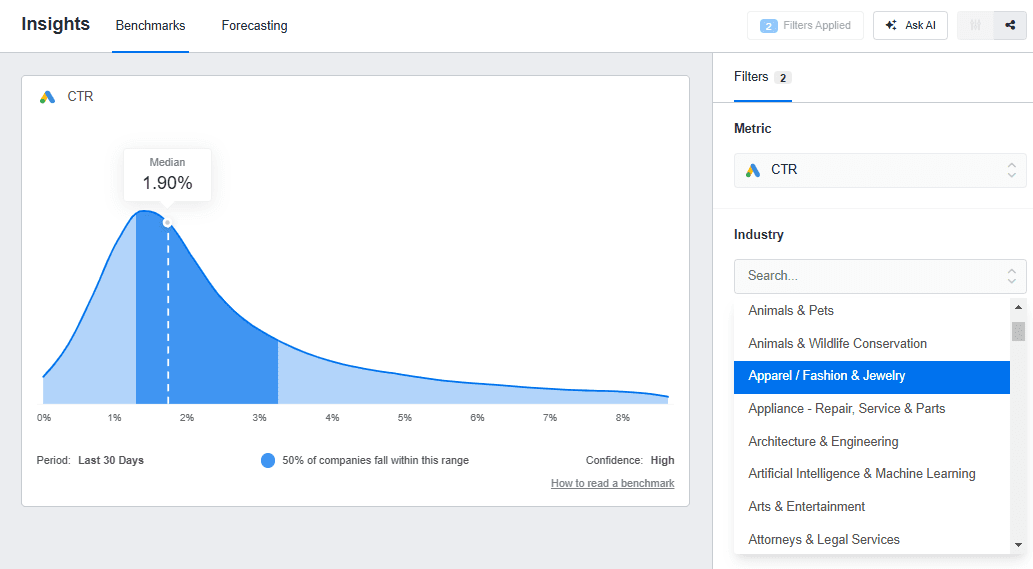
Build dashboards your clients actually understand. Want a view with just Yelp profile views, map clicks, and CTA button usage? Easy. Need another that tracks Google search impressions, shopping ads, and video views? Done. It’s all drag-and-drop.
Automate reporting (for real): Deliver scheduled, branded reports with filters, visuals, and commentary so your clients see the story behind the numbers, without any extra work on your end.
Tie it all back to ROI: Your clients don’t care about raw clicks. They care about booked jobs, new customers, and results. AgencyAnalytics lets you show exactly how their advertising dollars are working—whether they’re spending on Yelp Ads, Google Ads, or both.
Agency tip: New hire in training? Or just need a refresher yourself? These 22 Free Google Ads Tutorials walk through the metrics that matter.
Built for agencies: Unlimited client logins, white labeled dashboards, user permissions, and all the presentation tools you need to make your team look good.
One dashboard. Two platforms. Zero tab-hopping. Start your free trial and show clients exactly how their ad spend is performing—on Google, Yelp, or both.
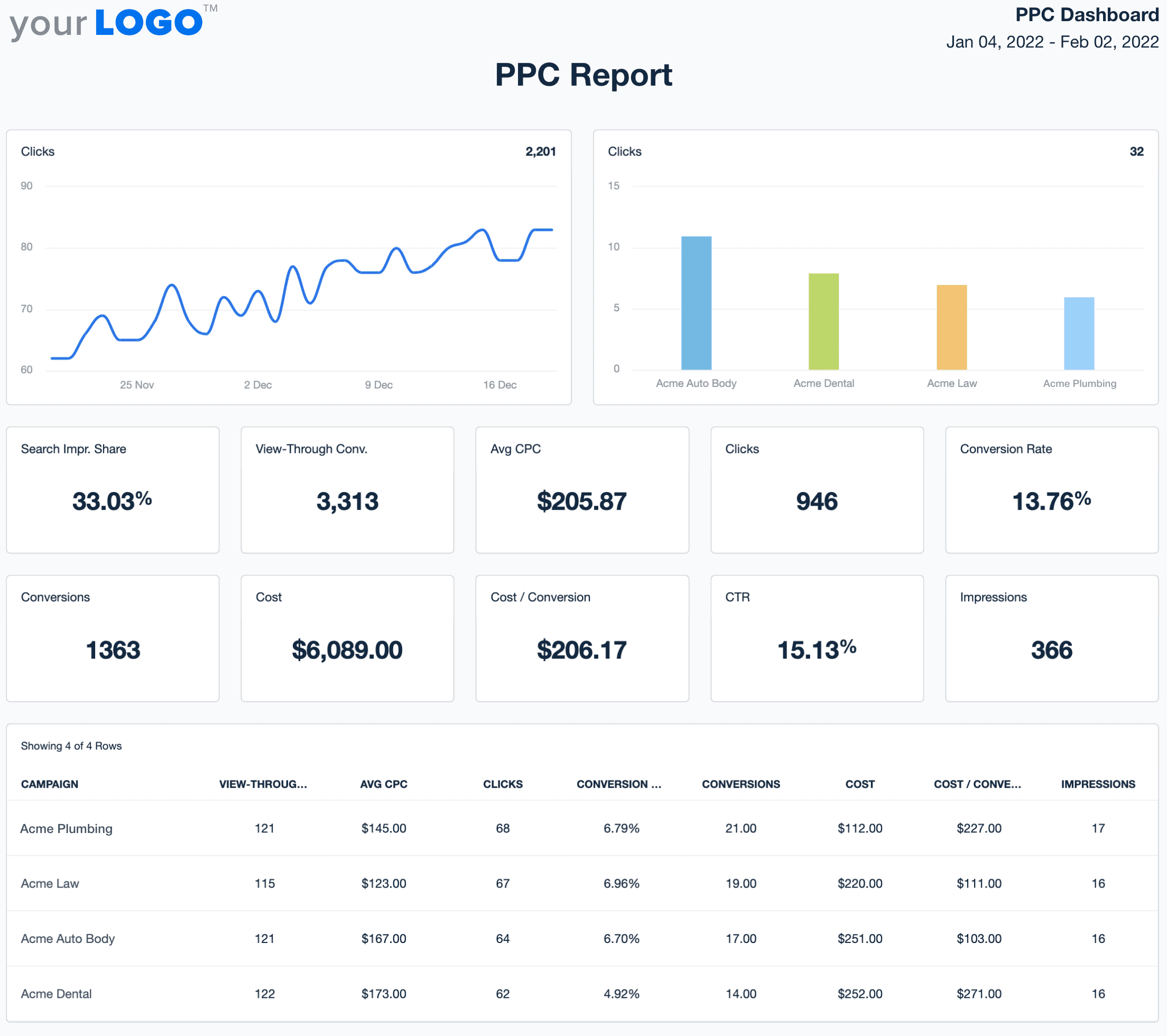
So, who wins in the Google Ads vs Yelp Ads match-up?
Honestly? It depends on your client, their goals, and where their customers are in the funnel. Google Ads gives you reach, targeting, and control. Yelp Ads brings timing, trust, and review-driven impact. Sometimes one is enough. Other times, you need both to get the job done.
AgencyAnalytics tracks them side by side, helping you turn cross-platform data into insights that drive smarter strategy and stronger results. Start your free trial and track ad performance the easy way.

Written by
Kali Armstrong is a freelance content writer with nearly a decade of experience crafting engaging, results-driven copy. From SEO blogs to punchy short-form pieces, she combines strategic insight with authentic messaging to captivate audiences and drive results.
Read more posts by Kali ArmstrongSee how 7,000+ marketing agencies help clients win
Free 14-day trial. No credit card required.



